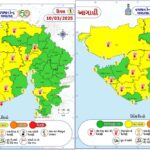Glaciers Melting at an Accelerated Rate
The survey utilized satellite images to reveal that the number of lakes in the Sutlej basin has reached 995 due to the melting of glaciers. As global temperatures continue to rise, glaciers in the Himalayas are melting faster, causing the formation of new lakes and the expansion of existing ones.
Increasing Number of Large Lakes
In the Sutlej basin, the number of lakes spanning over an area of more than 10 hectares has increased to 62. This is concerning when considering past incidents like the Kedarnath spill in 2013 and the Par Lake spill in 2000. The increase in large lakes within a relatively short period of two years could pose a threat to many states in the region, as explained by Dr. Surjit Randhawa, Sr. Scientific Officer at Himcast.
The Potential Danger of Lake Bursts
The growing number of lakes, coupled with climate change and rising temperatures in high altitudes, is creating a potential risk for catastrophic lake bursts. As glaciers melt, water collects and gradually expands the lakes’ size. Himachal Pradesh, for instance, experienced significant devastation from the Parchu Lake burst in 2000
As a conscious citizen, I feel deeply concerned about the impact of climate change on our environment, particularly the rapid melting of glaciers and the increasing number of lakes in the Sutlej basin. This alarming situation poses a potential threat to nearby states, and I believe it is crucial for all of us to come together to address this issue. In this blog post, I will share my thoughts on what we can do as individuals and communities to mitigate the effects of climate change and protect our environment.
• Raising Awareness About Climate Change
It is essential to understand the role of climate change in causing the glaciers to melt rapidly, leading to the formation of new lakes. As conscious citizens, we should spread awareness about the impact of climate change and encourage others to take collective action to reduce our carbon footprint.
• Adopting Sustainable Living Practices
We must recognize that our daily choices and habits have a significant impact on the environment. By adopting sustainable living practices such as conserving energy, reducing waste, and using public transportation, we can make a positive difference in combating climate change.
• Advocating for Preventive Measures
We should urge our government and local authorities to implement preventive measures that address the growing number of lakes and the risks associated with potential lake bursts. This can include monitoring lake levels, developing early warning systems, and reinforcing vulnerable infrastructure.
• Supporting Research and Monitoring
It is vital to stay informed about the environmental changes happening in our world. As conscious citizens, we should support ongoing research and monitoring efforts that can help identify potential threats and develop appropriate strategies to address them.
• Encouraging Education and Community Involvement
We must value the importance of educating ourselves and others about the risks associated with melting glaciers and the increasing number of lakes in the Sutlej basin. By participating in community initiatives, joining environmental organizations, and sharing information with our friends and family, we can inspire change and help protect our environment for future generations.
Conclusion
The situation with melting glaciers and growing lakes in the Sutlej basin serves as a reminder of the urgent need for action to address climate change. As conscious citizens, we all have a responsibility to protect our environment and ensure a sustainable future for ourselves and generations to come. Let us work together to make a positive impact and create a world where nature thrives in harmony with humanity.
The Potential Danger of Lake Bursts
The growing number of lakes, coupled with climate change and rising temperatures in high altitudes, is creating a potential risk for catastrophic lake bursts. As glaciers melt, water collects and gradually expands the lakes’ size. Himachal Pradesh, for instance, experienced significant devastation from the Parchu Lake burst in 2000







